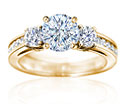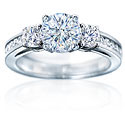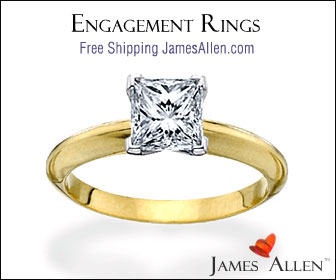Choosing a Ring Metal
Often in all the excitement and stress of choosing a diamond for an engagement ring, the ring metal type is decided without a lot of thought. There are quite a few choices, as described here.
Sponsored Links
Save 10% Off Your Ring Setting
Engagement Ring Guru has partnered with James Allen to provide you with an unique 10% off any engagement ring setting coupon code. Just type in "ringgu10" during the purchase process and you'll get 10% off the ring setting price (doesn't include the diamond).
So for example, if you picked a solitaire ring setting worth $800 and a diamond worth $2000, you'd save $80 off the total price. Not bad for only typing in 8 characters!
Yellow Gold
|
Pure gold is "24K". However, most engagement ring settings used gold that is somewhere between 9K and 18K. The lower the number, the more other metals are in the ring. This may sound bad, but it's a good thing - these other metals serve to make the ring stronger and less likely to scratch or dent over the many years it'll be on someone's finger. Yellow gold is great when combined with diamonds that have a low colour grade of say J or below, as it makes the colour less noticeable. I've picked a couple of nice examples of yellow gold rings on the left - click on them to get a closer look. |
White Gold
|
White gold is normal gold alloyed with a white metal. It's usually about the same price as yellow gold, and many retailers or online sellers will only display a ring setting in one type of gold with the understanding that they can easily do it with the other type if needed. White gold may contain nickel however, which can be an allergy problem for some people (who may not realise until they wear the ring - check it first!). I've picked a couple of nice examples of white gold rings on the left - click on them to get a closer look. |
Platinum
|
Platinum is white in appearance (looks closer to white gold than yellow gold) and quite expensive. It's very strong and resistant to daily wear and tear. Even on yellow gold rings, platinum is often the metal that the prongs which hold the diamond are made out of. I've picked a couple of nice examples of platinum rings on the left - click on them to get a closer look. |
Silver
 |
Sterling silver is a bit over 90% silver with the rest being made up of other metals such as copper. You don't get pure silver rings because it's way too soft and won't last. It's usually cheaper than the other metals, but may show wear more obviously and possibly has the nickel allergy problem mentioned for white gold. |








